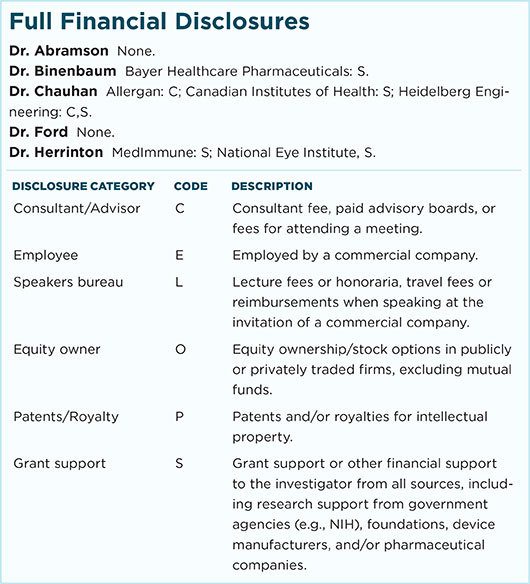Download PDF
After examining several neuroretinal parameters typically used to monitor the rate of glaucomatous change, researchers have found that disease is not the only cause of anatomic progression. Age also appears to play a significant role in structural loss.1
How age figures in. “We found that healthy aging explains a large proportion of the change we see in glaucoma patients,” said Balwantray C. Chauhan, PhD, Mathers Professor, Department of Ophthalmology and Visual Sciences, Dalhousie University, in Halifax, Canada. “Aging is a powerfully important variable that we are now beginning to fully appreciate.”
The study involved 192 treated open-angle glaucoma patients (median age, 68.7 years) and 37 healthy controls (median age, 65.2 years) observed at 6-month intervals for an average of 4 years. All subjects underwent confocal scanning laser tomography (CSLT) to measure the global disc margin–based neuroretinal rim area. Optical coherence tomography (OCT) was used to measure Bruch’s membrane opening (BMO) minimum rim width, BMO area, and peripapillary retinal nerve fiber layer (RNFL) thickness.
Among the key findings:
- More than 30% of healthy control subjects had a significant reduction of neuroretinal parameters.
- After adjusting for the effects of aging, the difference in rate of change of OCT-based neuroretinal parameters is still worse in treated glaucoma patients compared with controls, but the difference is not statistically significant. “In other words, aging explains most of the significant changes that are observed in well-treated glaucoma patients and controls,” Dr. Chauhan said.
- Minimum rim width and RNFL thickness showed significant loss with normal aging, but disc margin–based neuroretinal area did not, probably because it is a less accurate measurement of the rim, Dr. Chauhan said.
The latter finding underscores the importance of OCT as a clinical tool and reinforces a message previously put forth by Dr. Chauhan and colleagues— that OCT allows clinicians to appreciate optic nerve head and RNFL anatomy in a way not possible before.
The findings weren’t completely unexpected. “We did know that aging would have an effect on the neuroretinal parameters,” Dr. Chauhan said. “However, I was surprised to see how powerful the effect was.”
Putting these results into practice. The clinical challenge raised by these findings is how to make practical use of them. One strategy would be to remove the effects of aging from clinical calculations, Dr. Chauhan said. But he acknowledged the practical limitations of that approach because there is enormous variation in the effects of aging in the normal population. A further complication to statistical adjustment is that baseline levels of damage can have significant impact on rates of change.
Nevertheless, Dr. Chauhan is seeking to incorporate these findings into practical guidelines for clinicians. “We’re hoping to use this work as a springboard to develop tools for the clinician to segregate out the effects of aging. There could be indices within what we are measuring that could be specific just to glaucoma.” Ultimately, this could lead to more accurate predictions of glaucoma progression.
Meanwhile, he said, “Consider that not all change that you see in your glaucoma patients is due to the disease itself.”
—Miriam Karmel
___________________________
1 Vianna JR et al. Ophthalmology. 2015;122(12):2394-2400.
___________________________
Relevant financial disclosures—Dr. Chauhan: Allergan: C; Canadian Institutes of Health Research: C; Heidelberg: C,S.
For full disclosures and disclosure key, see below.

More from this month’s News in Review